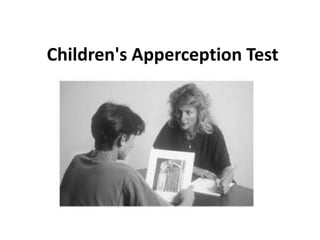
Children's apperception test
- 2. PROJECTIVE TEST • A projective test is a personality test designed to let a person respond to ambiguous stimuli, presumably revealing hidden emotions and internal conflicts. • This is sometimes contrasted with a so-called "objective test" in which responses are analyzed according to a universal standard (for example, a multiple choice exam). • The responses to projective tests are content analyzed for meaning rather than being based on presuppositions about meaning, as is the case with objective tests. • The Children's Apperception Test, often abbreviated as CAT, is an individually administered projective personality test appropriate for children aged three to 10 years.
- 3. Purpose • The CAT is used to assess personality, level of maturity, and, often, psychological health. • The theory is that a child's responses to a series of drawings of animals or humans in familiar situations are likely to reveal significant aspects of a child's personality. • Some of these dimensions of personality include level of reality testing and judgment, control and regulation of drives, defenses, conflicts, and level of autonomy.
- 4. Description • The CAT, developed by psychiatrist and psychologist Leopold Bellak and Sonya Sorel Bellak and first published in 1949, is based on the picture-story test called the Thematic Apperception Test (TAT). • The TAT, created by psychologist Henry A. Murray for children (ten years old and older) as well as adults, uses a standard series of 31 picture cards in assessing perception of interpersonal relationships. • The cards, which portray humans in a variety of common situations, are used to stimulate stories or descriptions (orally or in writing) about relationships or social situations and can help identify dominant drives, emotions, sentiments, conflicts and complexes. • The examiner summarizes and interprets the stories in light of certain common psychological themes.
- 5. Description • In creating the original CAT, animal figures were used instead of the human figures depicted in the TAT because it was assumed that children from three to ten years of age would identify more easily with drawings of animals. • The original CAT consisted of ten cards depicting animal (CAT-A) figures in human social settings. • The Bellaks later developed the CAT-H, which included human figures, for use in children who, for a variety of reasons, identified more closely with human rather than animal figures. • A supplement to the CAT (the CAT-S), which included pictures of children in common family situations, was created to elicit specific rather than universal responses.
- 7. Administration • The CAT, which takes 20–45 minutes to administer. • Can be conducted by a trained professional—psychiatrist, psychologist, social worker, teacher or specially trained pediatrician—in a clinical, research, or educational setting. • The test may be used directly in therapy or as a play technique in other settings. • After carefully establishing rapport with the child, the examiner shows the child one card after another in a particular sequence (although fewer than ten cards may be used at the examiner's discretion) and encourages the child to tell a story—with a beginning, middle, and end—about the characters. • The examiner may ask the child to describe, for example, what led up to the scene depicted, the emotions of the characters, and what might happen in the future.
- 8. Scoring • In a projective test such as the CAT, there is no right or wrong answer. • Thus there is no numerical score or scale for the test. • The test administrator records the essence of each of the stories told and indicates the presence or absence of certain thematic elements on the form provided. • As in the TAT, each story is carefully analyzed to uncover the child's underlying needs, conflicts, emotions, attitudes, and response patterns. • The CAT's creators suggest a series of ten variables to consider when interpreting the results. • These variables include the story's major theme, the major character's needs, drives, anxieties, conflicts, fears, and the child's conception of the external world.
- 9. Reliability and validity • Although responses in projective tests are believed to reflect personality characteristics, many experts have called into question the reliability, validity, and hence, usefulness of these tests as diagnostic techniques. • The CAT, as well as other projective measures, has been criticized for its lack of a standardized method of administration as well as the lack of standard norms for interpretation. • Studies of the interactions between examiners and test subjects have found, for example, that the race, gender, and social class of both participants influence the stories that are told as well as the way the stories are interpreted by the examiner.
- 10. USES • The CAT, which is designed for use in clinical, educational, and research settings, provides the examiner with a source of data, based on the child's perceptions and imagination, for use in better understanding the child's current needs, motives, emotions, and conflicts, both conscious and unconscious. • Its use in clinical assessment is generally part of a larger battery of tests and interview data.
- 11. References • McCoy, Dorothy. The Ultimate Guide to Personality Tests. Inglewood, CA: Champion Press, 2005. • Paul, Annie Murphy. The Cult of Personality: How Personality Tests Are Leading Us to Miseducate Our Children, Mismanage Our Companies, and Misunderstand Ourselves. Riverside, NJ: Simon & Schuster, 2004. • Camara, W. J., et al. "Psychological test usage: implications in professional psychology." Professional Psychology: Research and Practice 31 (2000): 141–54. • Kamphaus, R. W., et al. "Current trends in psychological testing of children." Professional Psychology: Research and Practice 31 (2000): 155–64.
